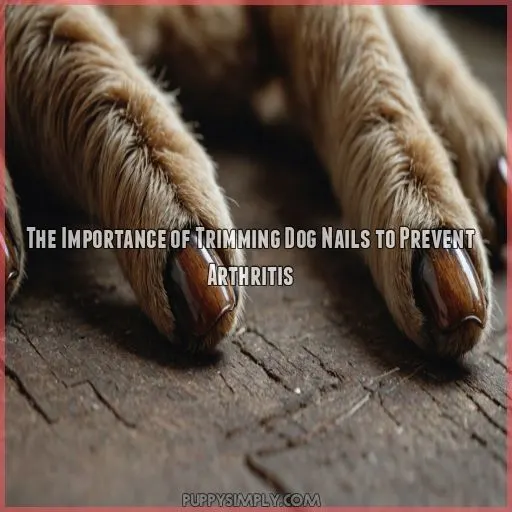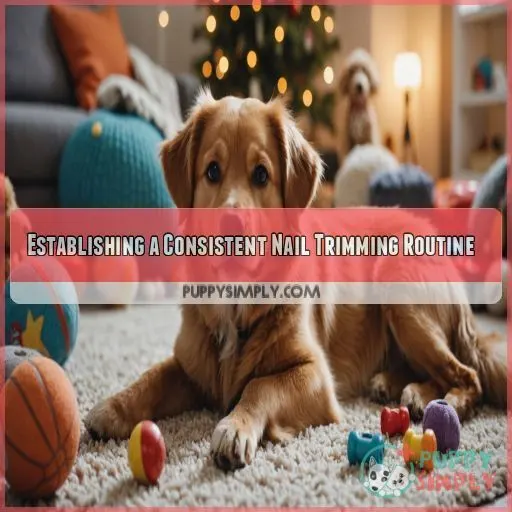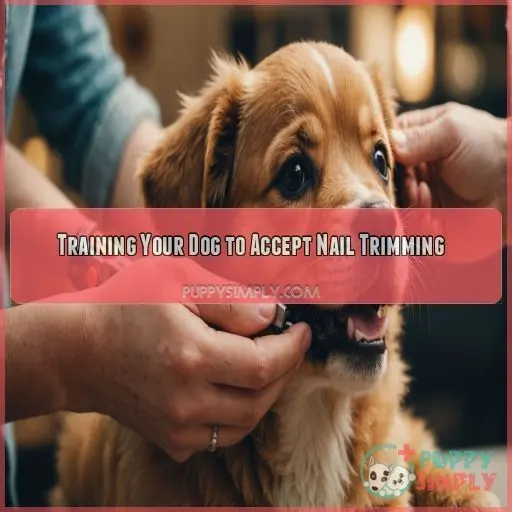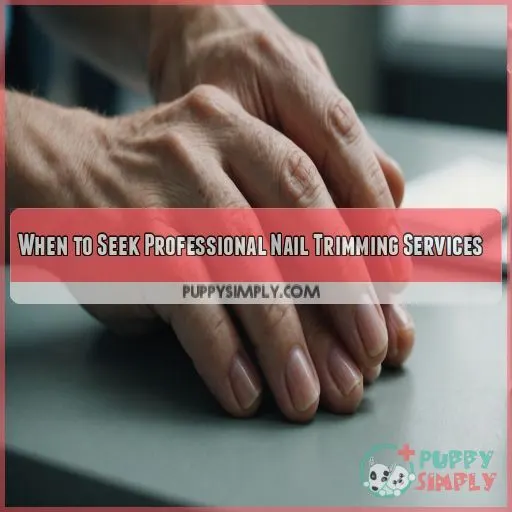This site is supported by our readers. We may earn a commission, at no cost to you, if you purchase through links.
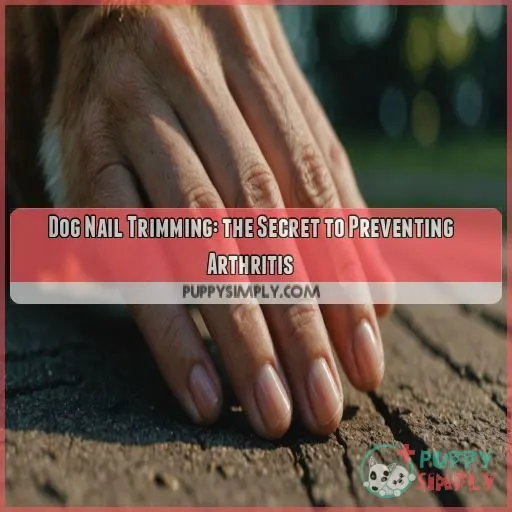
It’s like forcing them to wear high heels 24/7 – over-grown nails change their gait and put pressure on their joints.
Aim to trim nails every 3-4 weeks, listening for that tell-tale clicking on the floor.
If you let nails get too long, it can cause discomfort and make it hard for them to get traction on slippery surfaces.
Stay calm, use the right tools, and reward them with treats.
Don’t worry if nail trims are a struggle – a professional groomer or vet can handle it easily.
Your dog will thank you in the long run!
Table Of Contents
- Key Takeaways
- The Importance of Trimming Dog Nails to Prevent Arthritis
- Establishing a Consistent Nail Trimming Routine
- Techniques for Stress-Free Nail Trimming
- Training Your Dog to Accept Nail Trimming
- When to Seek Professional Nail Trimming Services
- Frequently Asked Questions (FAQs)
- How do I condition my dog for nail trimming?
- How to desensitize a dog to nail trims?
- What is the least painful way to trim a dog’s nails?
- How do wild dogs keep their nails trimmed?
- What is the ideal length for a dogs nails?
- How can I tell if my dogs nails are too long?
- What are the signs of discomfort from overgrown nails?
- Can I trim my dogs nails at home if they are black?
- What tools are recommended for trimming a dogs nails?
- Conclusion
Key Takeaways
- Trimming your dog’s nails every 3-4 weeks is crucial to prevent painful arthritis and mobility issues down the line, as overgrown nails can strain delicate paw structures. Overgrown nails can dramatically impact their gait and put undue pressure on their joints.
- Gather the right tools, such as sharp dog nail clippers, styptic powder, and a nail file, to make nail trims a breeze. Stay calm, use proper clipping technique, and reward your pup with treats for a stress-free experience.
- Train your dog to accept nail trims by getting them comfortable with the clippers, gradually desensitizing them to paw handling, and creating a positive association with the process. This makes nail care a cinch for both of you.
- If your dog is difficult to handle during nail trims, don’t worry – the skilled groomers at Rossmore Vets can safely and efficiently trim their nails, giving you peace of mind. They’ll make sure your pup’s nails are at the perfect length to prevent any issues.
The Importance of Trimming Dog Nails to Prevent Arthritis
As a devoted dog parent, you know their paws are more than just cute appendages – they’re really important for your pup’s overall health and mobility.
Trimming your dog’s nails regularly is the secret to preventing painful arthritis down the line by avoiding cutting nails too short. Long nails can dramatically impact your canine’s gait, putting undue pressure on their joints and leading to debilitating joint issues.
Think of it like you wearing high heels 24/7 – ouch! This constant strain can cause serious problems for your dog.
Establishing a Consistent Nail Trimming Routine
Establishing a consistent nail trimming routine is key to your dog’s well-being, especially when you consider the health risks of overgrown nails.
From determining the best frequency to recognizing the signs it’s time for a clip, we’ll cover everything you need to know to keep those nails in tip-top shape.
Determining the Optimal Trimming Frequency
Aim to trim your dog’s nails every 3-4 weeks.
But remember, outdoor pups may need less frequent trims as their nails wear down naturally.
The key is paying attention to the sound of their nails on the ground – if you hear that tell-tale clicking, it’s time for a trim.
Signs That Your Dog Needs a Nail Trim
You’ll know it’s time for a nail trim if you hear your pup’s nails clicking on the floor as they walk.
Overgrown nails can also cause discomfort, changing their gait and potentially leading to more serious issues like arthritis down the line.
Keep an eye out for nails that are curling under or excessive wear on the tips.
Understanding Why Dogs May Resist Nail Trims
Dogs often resist nail trims, but it’s not because they know you’re trying to help.
Your pup simply doesn’t understand the process.
Past bad experiences, anxiety about pain or discomfort, and a natural fear of the unknown can all make dogs wary of nail trimming, especially when they have a history of anxiety.
But with patience and positive associations, you can ease their worries.
Techniques for Stress-Free Nail Trimming
Wielding the right tools and supplies is key for a smooth, stress-free nail trim.
With the proper clipping technique, you can avoid any nicks or injuries and keep your pup comfortable.
Using the Appropriate Tools and Supplies
To ensure a stress-free nail trim, it’s essential to have the right tools.
Opt for dog-specific clippers that are sharp and sturdy. This will help prevent any accidents or injuries to your pup.
In case of any accidental nicks, keep styptic powder nearby to stop the bleeding.
Additionally, consider using a nail grinder or file to smooth out rough edges after clipping.
Before you start, make sure to gather these essentials to tackle your pup’s pedicure.
Proper Clipping Technique to Avoid Injury
Hold your dog’s paw firmly and locate the quick – that pink nerve running through the nail.
Clip at a 45-degree angle, snipping just the tip. Avoid cutting too close and nicking the quick, which can cause bleeding.
Have styptic powder on hand to quickly stop any nicks.
Stay calm and reward your dog’s cooperation with treats – the key to stress-free nail trims.
Training Your Dog to Accept Nail Trimming
Training your pup to accept nail trims can seem tough, but with patience and positive reinforcement, you’ll have them sitting pretty in no time.
Whether you’ve got a wiggly puppy or a stubborn senior, we’ll walk you through the simple steps to make nail care a breeze for both of you.
Acclimating Puppies to the Process
Get your puppy used to nail trims early on. This is an essential step in making nail care a stress-free experience for your puppy.
Let them investigate the clipper – it’s no biggie. This initial introduction will help your puppy become familiar with the clipper and reduce anxiety.
Clip just the tips, praising and rewarding as you go. This approach will help your puppy associate nail trims with positive reinforcement.
Turning nail time into a positive experience takes time, but it’ll pay off with a calmer, more cooperative pup down the line.
Desensitizing Older Dogs to Nail Trims
If your older dog has trouble tolerating nail trims, don’t worry – with time and patience, you can gradually desensitize them.
Start by simply touching their paws and offering treats, then work up to holding their toes. This helps your dog become comfortable with the process.
Take it slow, monitor for signs of stress, and always end on a positive note. This builds trust and makes nail trims a breeze.
Developing a Positive Association With Nail Clippers
You can help your dog learn to love nail trimming by creating a positive association with the clippers.
Start by grabbing the clippers and immediately rewarding your pup with treats and praise – this teaches them nail trims mean good things.
Over time, progress to letting them sniff and touch the clippers before trimming.
With patience and consistency, you’ll have a calm, cooperative canine companion during nail care.
When to Seek Professional Nail Trimming Services
If your dog is difficult to handle during nail trims or you’re unsure about the process, it’s time to enlist the help of the experts.
Luckily, the veterinarians at Rossmore Vets have the skills and experience to safely and efficiently trim your pup’s nails, giving you peace of mind.
Recognizing Signs of Difficulty or Distress
Does your pup seem to whine, shiver, or tuck their ears back during nail trims?
Maybe they start panting or licking their lips?
These are signs they’re feeling distressed.
Pups who fight nail trims may be more prone to mobility issues and arthritis later on.
It’s best to have a professional handle this task if your dog seems overwhelmed.
Benefits of Having a Groomer or Veterinarian Trim Nails
Professional groomers and vets have the right tools, training, and patience to trim your dog’s nails safely and comfortably for a safe and comfortable experience.
They can quickly and efficiently get the job done without stressing your pup.
Plus, they’ll make sure your dog’s nails are trimmed to the best length to prevent any painful issues down the line, like paw deformities.
Accessing Nail Trimming Services at Rossmore Vets
Looking for professional dog nail trims?
Rossmore Vets is a great option.
Their skilled groomers can safely and efficiently trim your pup’s nails.
You can book an appointment by calling (123) 456-7890 or visiting their website.
Expect a reasonable fee of $25-$40.
Your canine companion will leave feeling comfortable and relaxed.
Frequently Asked Questions (FAQs)
How do I condition my dog for nail trimming?
Make nail trims a positive experience for your pup.
Start by getting them comfortable with the clippers.
Then, work up to gentle paw handling.
Reward their cooperation with tasty treats and praise.
They’ll be a pro in no time!
How to desensitize a dog to nail trims?
Make nail trims a positive experience for your dog by associating the clippers with treats.
Give your dog a treat whenever they see the clippers.
Gradually work up to handling their paws.
Once they are comfortable with that, start by trimming just the tips of their nails.
Take it slow and provide lots of praise.
You’ve got this!
What is the least painful way to trim a dog’s nails?
You’ll be the canine’s best friend if you clip their nails like a pro!
Use sharp, pet-friendly trimmers and take it slow – a few nails at a time.
Reward their patience with yummy treats, and you’ll both be dancing with joy.
How do wild dogs keep their nails trimmed?
Wild dogs’ nails don’t need trimming – they naturally wear down from roaming and digging.
Your domestic pup, though, can’t keep up with that pace, so you’ll need to clip their nails every few weeks for their comfort and health.
What is the ideal length for a dogs nails?
You should trim your dog’s nails when they’re long enough to click on hard floors.
This means the nails are long enough to touch the ground when your dog walks.
The perfect length lets them walk comfortably without the nails touching the ground.
Aim to keep them trimmed every 3-4 weeks.
How can I tell if my dogs nails are too long?
Isn’t it funny how that clickety-clack sound from your dog’s nails suddenly gets louder on hard floors?
Check if they’re too long when touching the ground while standing.
Long nails might alter Fido’s stride.
What are the signs of discomfort from overgrown nails?
Overgrown nails can cause your dog discomfort, like limping, favoring one paw, or excessive licking/chewing at their feet.
Regularly trimming their nails helps prevent these issues and keeps your pup happy and healthy.
Can I trim my dogs nails at home if they are black?
Absolutely, you can trim your dog’s black nails at home!
Just take a steady-as-she-goes approach: clip small tips, and avoid the quick.
Use a flashlight to help spot the quick.
Don’t forget the treats! (Source)
What tools are recommended for trimming a dogs nails?
Grab dog-specific nail clippers, styptic powder, and a nail file – they’re your tools of the trade!
Clipping Fido’s nails shouldn’t make you break a sweat.
Keep treats handy because even dogs prefer mani-pedis with some reward.
Conclusion
Isn’t it a coincidence that something as simple as "Dog nail trimming: how to prevent arthritis" can offer such significant health benefits for your furry friend?
By sticking to a trimming schedule, using the right tools, and creating a positive experience, you’re protecting your dog from discomfort and long-term joint issues.
If all else fails, remember that professionals are just a call away. Your dog will be grateful!

